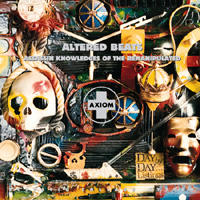
Interesting article I came across in Waxpoetic’s online archives, featuring Bill Laswell. The article goes into the Altered Beats album (Assassin Knowledges of the Remanipulated) and touches on Laswell’s take on certain elements of HipHop as a postmodern expression of that ancient desire to escape the confines of time, or at least that’s part of it, I think. The album, which I’ve never actually listened to, features many djs and turntablists including Prince Paul, Rob Swift and Scratch Pickles. You can go here for clips. Here’s an excerpt of Rammellzee’s contribution to the liner notes:
When you stop from the last number of infinity, where is it? Zero repeating to positive, zero repeating to negaitve — just because you’ve gotten higher, just because you went lower. Hyperbola to parabola to death. It’s five on a dime — can you spin it? — rise to nine. I’m a gargoyle in argyle socks. Yes…I love syntax because it’s natural, it flows, it’s like a mountain turning into a molehill: it has to rain for thousands and thousands of years. What is old is old; what is new is very rare.”
Excerpt:
By: Brian DiGenti-Originally published May 1997 // 12.03.01.
‘References to “the business” and conspiracy theories—from government-alien pacts to the New World Order—abound in hip-hop and rap. Rappers often cite CIA scandals as proof of a conspiracy to control the black population, while others rap that the all-powerful, manipulative Illuminati is after them. These ideas rear their multiple heads in Altered Beats, especially on DXT’s “Embryo,” which features a speech about the supposed One-World Government that the United Nations is conspiring to implement—it’s a recording made during the Vietnam War era, and it reminds us that these theories are not new. Laswell, however, sees these as less literal, and more symbolic. He connects “all those references to New World Order and conspiracy theories” directly to “a very real part of a systematized control mechanism that you have to filter any of this experimentation through in order to produce a result at the other end.”
For Laswell, as artist, the ultimate conspiracy is that of time itself. “Just to get out of time,” Laswell ponders, “if we can move out of that sort of prison, then we’re basically onto something else. That was the whole concept within Brion Gysin and William S. Burroughs’s work: Time is that which ends.’ And as long as we’re inside that, we’re always moving toward an ending and we’re always kind of stuck on the calendar or on the clock face, within the number.” The employment of the Gysin-Burroughs cut-up technique (originally done by literally cutting up a finished manuscript and rearranging its parts, such as in the Burroughs novel Naked Lunch) is another way around ordinary methodology. “By using random elements to create new space, you’re trying to erase a method, trying to erase a routine and a regimented process,” he says. “And you can say you erased time by doing that.”‘



